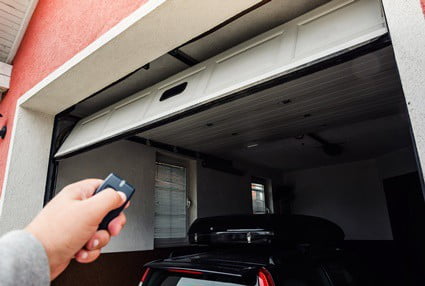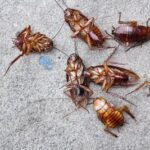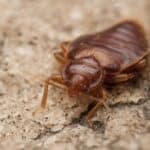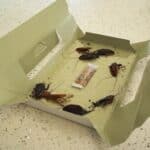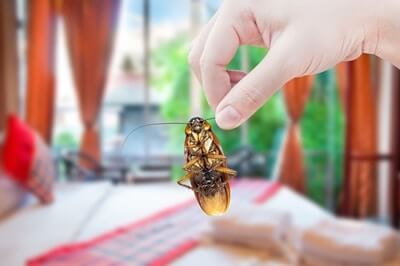You don’t expect to find roaches in your garage. If you see these pests scurrying around your car or storage items, then they likely live nearby. Roaches are just as able to build colonies in garages as anywhere else. Even if less food and water are available, cockroaches will soon discover other benefits.
Roaches like garages as they provide seclusion. Garages have less foot traffic and are used for storage. This provides a roach colony with ample shelter to breed and scavenge for food. You may fail to notice plumbing leaks in the garage, which roaches use for water. Any trash, pet food, paper, cardboard, or leaf debris is a source of food.
Garages are common areas for roach infestations. With their large doors, they provide more direct access to the outside world. A large infestation may also spill out from your kitchen into the garage.
What Causes Cockroaches In Garage?
A garage is not filled with food like a kitchen, nor does it have the water supply of a bathroom. Nonetheless, this area of the home does offer several advantages to cockroaches. These pests will first seek out better areas of the home, but they can be motivated to live in a garage because:
- The home is too clean or lacks exposed food sources that roaches can manipulate.
- Extermination methods have driven them out of other areas.
- The main roach infestation is too large and has spilled into the garage.
Once there, roaches can thrive. All they need is a few weak points in your garage to manipulate, such as:
Lack of Cleanliness
Roaches thrive in areas with rotting debris, leftover food, mold, and mildew. These are traits often found in unclean areas of the home, including garages. For example, your garage may contain:
Debris
In the wild, roaches eat rotting carcasses, decaying leaf matter, and several other materials. Garages have more contact with the outside world. As a result, they’re more likely than your home to experience a build-up of these materials.
Your vehicles may bring in grim, trace remains of roadkill, and leaf debris on their tires. Your kids’ bicycles may also track in mud after a rainy day. If you leave the garage open to air it out or work in the area, the direct contact with the outside may let various debris drift in. The result is more of a roach’s natural food spread across a garage.
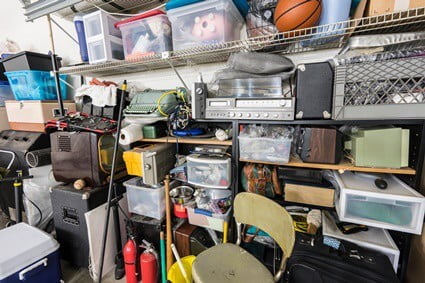
Unwashed Recyclables
While it’s recommended that you wash any items you recycle, not everyone does. If you leave food or other material on your glass, plastic, or cardboard, roaches can take notice. They’ll scurry through your recycling bin to eat leftovers.
Trash
Many people store trash bags in their garage. You may not be allowed to place your trash on the street in certain neighborhoods until collection day. Likewise, some people stow their trash indoors to avoid raccoons getting into their bins. While these fears are reasonable, be aware that you’re trading one pest for another. Storing bagged trash in your garage leaves temptation for a roach, including:
- Leftover food
- Items from your bathroom’s trash can
- Pet hair, skin flakes, dust, and crumbs from emptied vacuums
Roaches bite through the thin plastic of your trash bags and have a feast.
Lack of Activity
Unless you have a workshop in your garage, you probably don’t visit the space often. This means the garage sees little activity unless you’re parking your vehicle.
While cockroaches are quick to infest homes, they prefer quiet areas. This has a lesser risk of predators spotting and hunting them. Because of that, when your garage doesn’t see much foot traffic, cockroaches are likely to gather there.
Once they have entered, they can quickly increase in population. Eggs can be positioned throughout the garage without disturbance. Roach nymphs will be able to grow and feed without danger between molts. Adults can reproduce and expand the colony virtually threat-free.
To make matters worse, this reduced foot traffic also means you’re less likely to spot a colony. That can let it reach a considerable size before extermination measures are taken.
Sources of Moisture
Because of a lack of attention, garages are prone to leaking pipes and dripping hoses. In some circumstances, pipes can lead to puddles inside your garage. Leaks can also come from holes in the roof or improper roof drainage.
The leaks themselves may not cause much damage. However, roaches only need some moisture to survive. A study published in the Journal of Economic Entomology determined that American cockroaches can live without food and water for 42 days.
Aside from pipes and hoses, snow and rain can be a source of moisture in your garage. During the winter season, it’s easy to bring snow and rain from vehicles. Likewise, a lack of ventilation can also cause moisture in the air if you run appliances inside a cold garage.
Open To The Outside
Even the cleanest garage can still have roaches, as long as there is a way for them to enter. If your garage has windows, doors, or minor openings to the outside, this provides an invitation to the outdoors.
While your home is insulated and weatherproofed, your garage may not be. Garage doors may not be properly sealed. When they’re opened and closed to allow in cars, this provides a large opening. Garages are also rarely insulated, providing a lot of spaces for roaches to crawl through.
How To Get Rid of Cockroaches In Your Garage
There are ways to keep roaches out of your garage:
Take Out The Trash
If you store your trash in your garage, consider:
- Taking it out more frequently
- Storing it elsewhere
- Getting new containers
This, of course, depends on your trash collection service. If it’s possible to increase how often it’s collected, this can remove what’s attracting cockroaches. If that’s not possible, you’ll need to store your trash more securely.
Instead of stowing trash indoors and attracting pests, put them in outdoor bins and secure the lid. Wrapping it in a bungee cord will ward off any raccoons that may be trying to get inside your trash bin.
If you need to keep the trash indoors, consider getting new containers. These should be thick plastic with a lid that properly seals. Roaches will struggle to get into an otherwise airtight container.
Toss Out Paper And Boxes
Garages are often used for storage. Cockroaches will use these areas to hide and nest. Beyond that, however, you may be storing items in:
- Cardboard boxes
- Paper bags
- Newspapers
Not only does this provide shelter for roaches, but also food. These materials are organic and contain starch. This can be a source of nutrition for cockroaches. They will use this to fuel their expanding colony. Be sure to look through your garage for these items. Once you’ve found them, you can:
- Replace cardboard boxes with plastic for storage.
- If you keep paper products for recycling, but sure to seal them in a thick plastic container.
- If you have an infestation, it’s better to throw out the paper than risk bringing roaches into a clean home.
- If any of the items are moist or otherwise water-damaged, throw them out. Roaches will be attracted to the moisture as well as the softened material.
Rinse Plastic Containers
That doesn’t mean your airtight containers are entirely safe. Whether you’re storing trash, recyclables, or other items, the inside of these containers may get dirty. Roaches may not be able to get inside, but as you open and close them, tempting smells can waft out. If cockroaches are in your garage, this may encourage them to stay.
Regularly clean out your containers. If food residue or spills get on the container, wash it with soap and water. Unwashed containers can develop mold. This not only draws in roaches, but it’s also a health risk.
Store Pet Food In Containers
People often store bags of dog, cat, rabbit, and bird food in their garages. While this may be convenient, it’s also a surefire way to attract roaches into your home. These bags may not be properly sealed or be made of thin material, which a roach can eat through.
Ideally, you should place any food in an area that you can keep an eye on. This prevents roaches from gnawing through the bags. You’re also more likely to catch the roaches before they turn the bag into a consistent food source. Of course, you can also place the food in a separate, air-tight container. After that, make sure to:
- Clean up any spills
- Never leave the container open for too long
Remove Moisture
Roaches will huddle around leaks or puddles in your garage, so check your pipes for any fissures or cracks. If you find any, apply epoxy or other sealants.
Any puddles should be dried up and the source of the water removed. For example, rainwater may leak into your garage under the main door. If this is the case, seal up the gap under the door.
You can also check areas you know accumulate water and dry them up after storms. Removing sources of water is a great way to ensure that a roach population will not multiply.
Use Bait Traps
If you don’t spend time inside your garage, baited traps are an effective solution. They serve as small clusters of food laced with poison. Specifically designed to target roaches, they:
- Don’t require you to be present, unlike with roach spray
- Can be placed at strategic locations around your garage
- Can be more custom-tuned to roaches than bug bombs
- Baits lure roaches out of hiding, so you’ll kill more than just the ones you see
Some baits work in a delayed manner so that the roach will take the poison back to its nest. This can poison the other roaches. If the baited traps are placed and changed often, you can reduce the size of the infestation.

Address Other Areas
Roaches usually enter your garage from outdoors. However, they may also be gaining access from other places in your home. This is especially true for large infestations when one area cannot support the needs of a whole colony. Be sure to evaluate your kitchen, bathroom, and living room for signs of roaches. This may include:
Call A Professional
Baits, traps, and spray will counteract smaller colonies. If you’re dealing with a few roaches, you can also drive them out by removing their food and shelter sources. However, with large colonies, you may be unable to combat them.
Instead, it’s wise to contact a professional exterminator. These experts will have access to more advanced poisons. They can also provide insight on how to eradicate the infestation in your setting.
How To Keep Cockroaches Out Of Your Garage
Here are ways to keep roaches from finding their way back into your garage:
Seal Gaps And Cracks
According to the Proceedings of the National Academy of Sciences, roaches can squeeze through gaps as small as 3 mm in size. Be sure to check your garage for:
- Broken seals along windows or doors
- Gaps between the walls, floors, and ceilings
- Small holes around pipes, light fixtures, or in corners
This should also apply to any plumbing or air ducts throughout the garage.
Clean The Garage
Any possible shelters or food sources should be removed from the garage. While placing storage items in more secure containers is a good step, you should also:
- Clean out leaves, dirt, or other debris brought in by vehicles
- Clean up puddles or other water, especially after storms
- Check for any mold and mildew that may have grown over time
- Clear out spills, such as from trash or even oil from your car, as roaches may be attracted to this
Keep The Outdoors Neat And Tidy
Roaches live in the wild as well as indoors. The clearer your outdoor area is, the fewer roaches there will be close to your home. If they’re not close to your garage, they may not detect any tempting aromas.
- Clean your yard and tidy up leaf debris. Do this if hedges or flower beds line the pavement up to your garage
- Remove any items stored up against the garage or home. Roaches may reside in these areas.
- Remove piles of wood or fallen branches from the area.
- Clear out any puddles or standing water that’s accumulated around the garage area of your house.
Examine Objects That Come Into Your House
Roaches can hitch a ride on many objects. This is true whether they’re adults, nymphs, or in egg form. Be sure to examine all packages that come into your home, including:
- Old Christmas decorations. These may be moved into your garage from your attic.
- Delivered groceries, as these may arrive from warehouses that have roaches present.
- Clothing, especially from secondhand stores or your friends’ old storage boxes.
- Items from outdoors, such as yard equipment from a shed or hiking boots.
Roaches can be found in garages. With these preventative steps, you can drive them out and keep them away.
